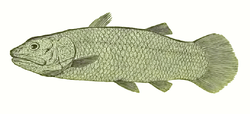Macropoma
| Macropoma Temporal range: Late Cretaceous, 70 Ma | |
|---|---|
 | |
| Life restoration of Macropoma | |
| Scientific classification | |
| Kingdom: | Animalia |
| Phylum: | Chordata |
| Class: | Sarcopterygii |
| Order: | Coelacanthiformes |
| Family: | Latimeridae |
| Genus: | Macropoma Agassiz, 1835 |
Macropoma (from Greek μακρός "large" + πόμα "cover", after its large operculum) is an extinct genus of coelacanth in the class Sarcopterygii. These fishes have apparently been extinct for over 70 million years and are most closely related to the modern coelacanth Latimeria.
Fossils of Macropoma have been found in both England and Czechoslovakia. Recorded fossils have bodies under two feet in length. A modern coelacanth measures five or more, but in other respects the two genera are remarkably similar, and share the same body plan with a three-lobed tail and stalked fins.[1]
Macropoma grew to a length of 22 inches (55 centimeters) and would have preyed upon smaller aquatic species.
References
- Barry Cox, Colin Harrison, R.J.G. Savage, and Brian Gardiner. (1999): The Simon & Schuster Encyclopedia of Dinosaurs and Prehistoric Creatures: A Visual Who's Who of Prehistoric Life. Simon & Schuster.
- David Norman. (2001): The Big Book Of Dinosaurs. page 61, Walcome books.
- Parker, Steve. Dinosaurus: the complete guide to dinosaurs. Firefly Books Inc, 2003. Pg. 69
This article is issued from Wikipedia - version of the Thursday, November 19, 2015. The text is available under the Creative Commons Attribution/Share Alike but additional terms may apply for the media files.